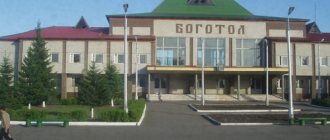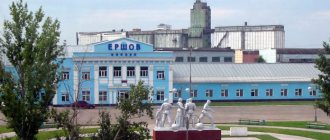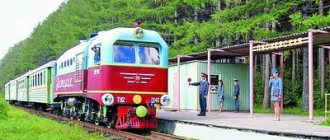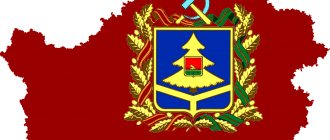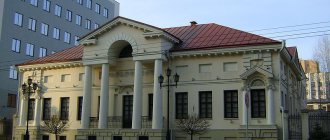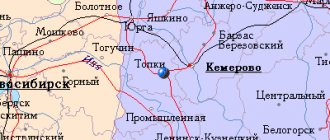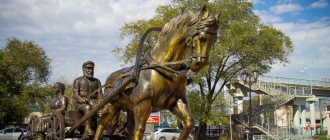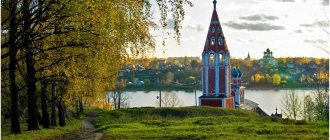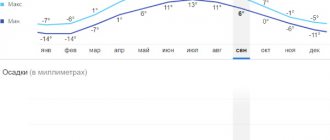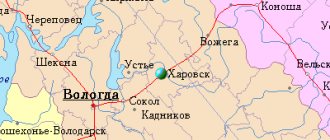Historians believe that Dmitriev was founded in the 7th–8th centuries AD. to strengthen the ties of ancient Russian tribes and protect against enemy attacks. In the 9th century, Prince Oleg the Prophet was involved in the construction of the city. He ordered the construction of a city on the site of the modern Old Town settlement, located in the village of Old Town on the right bank of the Svapa River. The Old Town settlement is classified as a Slavic monument of the 9th–13th centuries. Currently there is a cemetery on its territory.
Life at the site existed before the Mongol invasion, which, as is known, lasted from 1237 to 1240. In subsequent centuries, the lands on which the Dmitrievsky district and the city of Dmitriev are located today were ruined more than once, and the population was completely destroyed.
And only in the 17th century a settlement arose on the ruins, which later became known as the economic village of Dmitrievsky. The village received its name in honor of St. Demetrius of Thessaloniki.
The village of Dmitrievskoye was located on the bank of Svapa, indented by ravines. Its location was picturesque, but inconvenient, because residents obtained water from the river with “great difficulty,” as the planner noted. Two miles away, “on a flat site with a very capable population,” they decided to build a new village.
On May 23, 1779, by decree of Empress Catherine II, the village of Dmitrievskoye was transformed into the district town of Dmitriev. In 1780, a plan was drawn up for Dmitriev with the surrounding villages. In 1785, the city was renamed Dmitriev-on-Svap (or Dmitrosvapsk) in order to distinguish it from the city of Dmitrovsk, Oryol province.
Dmitriev
(Kursk region)
OKATO code:
38208501
Founded: City since:
1779 City of district subordination (Dmitrievsky district, Kursk region)
Center:
Dmitrievsky district
The city was formerly called:
| Dmitriev | 1779 | 1784 |
| Dmitriev-on-Svape | 1784 | 1929 |
| Telephone code (reference phone) | |
| 47150***** | 21-00-0 |
Deviation from Moscow time, hours:
0
Geographic latitude:
52°07′
Geographic longitude:
35°04′
Altitude above sea level, meters:
190 Sunrise and sunset times of the Sun and Moon in the city of Dmitriev
Education, culture
City monuments
In the city squares there are: a monument at the site of the execution of partisan Vera Tereshchenko, a memorial complex “In memory of those who fell in the Great Patriotic War of 1941-1945,” a monument to the partisans of the Great Patriotic War.
Map
| Dmitriev: maps |
Dmitriev: photo from space (Google Maps) Dmitriev: photo from space (Microsoft Virtual Earth)
| Dmitriev. Nearest cities. Distances in km. on the map (in brackets along roads) + direction. Using the hyperlink in the distance , you can get the route (information courtesy of the AutoTransInfo website) | |||
| 1 | Zheleznogorsk | 31 (37) | NE |
| 2 | Konyshevka | 34 (163) | SE |
| 3 | Komarichi (Bryansk region) | 37 (82) | NW |
| 4 | Sevsk | 39 (97) | Z |
| 5 | Khomutovka | 40 (55) | SW |
| 6 | Dmitrovsk | 43 (56) | WITH |
| 7 | Lgov | 49 (143) | YU |
| 8 | Fatezh | 54 (95) | IN |
| 9 | Lokot (Bryansk region) | 60 (122) | NW |
| 10 | Trosna (Oryol region) | 60 (71) | NE |
| 11 | them. Karl Liebknecht | 62 () | SE |
| 12 | Kurchatov | 64 (174) | SE |
| 13 | Rylsk | 66 (101) | SW |
| 14 | Suzemka (Bryansk region) | 71 (132) | Z |
| 15 | Soskovo (Oryol region) | 73 (189) | WITH |
| 16 | Korenevo | 78 (127) | YU |
| 17 | Kromy (Oryol region) | 78 (91) | NE |
| 18 | Pryamitsyno | 79 (168) | SE |
| 19 | Shablykino (Oryol region) | 82 (202) | WITH |
| 20 | Ponyri | 86 (133) | IN |
| 21 | Navlya (Bryansk region) | 87 (159) | NW |
| 22 | Kursk | 88 (145) | SE |
| 23 | Zolotukhino | 90 (142) | IN |
| 24 | Glushkovo | 92 (130) | YU |
| 25 | Bolshoye Soldatskoye | 92 (188) | YU |
| 26 | Glazunovka (Oryol region) | 95 (195) | NE |
| 27 | Suja | 102 (161) | YU |
| 28 | Maloarkhangelsk | 102 (210) | IN |
| 29 | Trubchevsk | 102 (306) | NW |
| 30 | Naryshkino (Oryol region) | 104 (156) | NE |
a brief description of
Located on the southwestern edge of the Central Russian Upland, on the river. Svapa (Dnieper basin), 120 km northwest of Kursk. Railway station.
Territory (sq. km): 8
Information about the city of Dmitriev on the Russian Wikipedia site
Historical sketch
An ancient village on the river. Svapa (the right tributary of the Seim), known as Svapsk, eventually received the name Dmitrievskoye (after the church in the name of Demetrius of Thessaloniki).
In 1779, the village of Dmitrievskoye was transformed into the district town of Dmitriev of the Kursk governorate (since 1796 - Kursk province). To distinguish it from the cities of Dmitrov (Moscow province) and Dmitrovsk (Oryol province), an indication of its location was included in the name Dmitriev in 1784 and it became Dmitriev-on-Svape. This name was also used in the unofficial form Dmitrosvapsk and the colloquial, reinterpreted Dmitroslavsk, Dmitroslavl, Mitroslav.
In the vaults of 1859, 1898. city of Dmitriev. Official documents of the 1930s mention Dmitriev. In 1929, Dmitriev was called Dmitriev-Lgovsky, since at that time the city belonged to the Lgov district (before that - in the Lgov district). There is no information about the official date for renaming the city. [According to the 1939 population census, it is listed as Dmitriev-Lgovsky, the center of the Dmitrievsky district].
In 1856, in the district town of Dmitriev, Kursk province, there were 2 churches, 287 houses, 38 shops.
During the Great Patriotic War of 1941-45, the city was occupied by Nazi troops on October 8, 1941. It was liberated on March 2, 1943 by troops of the Central Front during an operation in the Sevsk direction.
Economy
Food industry enterprises: canning factories, butter factories, meat factories.
, hemp, obozotstroitelny.
Main enterprises
PRODUCTION OF CANNED FRUITS AND VEGETABLES
OJSC "Agro-industrial corporation 'Dmitrievkonservy'"
307500, Kursk region, Dmitrievsky district, Dmitriev, st.
Promyshlennaya, 1 Offers:
canned fruits and vegetables, meat, tomatoes, juices, baked goods
Culture, science, education
Museum of Local Lore.
Writer Yu.P. studied in Dmitriev-Lgovsky. Hermann.
Museums, galleries, exhibition halls
Dmitrievsky State Local Lore Museum named after. A.F. Vangengeyma 307500, Kursk region, Dmitrievsky district, Dmitriev, st. Lenina, 47 Phone(s): (47150) 2-1448 Website: https://kursk-museum.ru/
Architecture, sights
Memorial with an eternal flame in memory of those killed in the Great Patriotic War of 1941-45.
| Population by year (thousands of inhabitants) | |||||||
| 1856 | 2.8 | 1979 | 10.5 | 2005 | 8.3 | 2014 | 7.1 |
| 1897 | 6.1 | 1989 | 11.2 | 2006 | 8.1 | 2015 | 6.8 |
| 1913 | 6.9 | 1992 | 11.2 | 2007 | 8.0 | 2016 | 6.8 |
| 1926 | 4.7 | 1996 | 11.0 | 2008 | 7.9 | 2017 | 6.6 |
| 1931 | 5.7 | 1998 | 10.9 | 2010 | 7.6 | 2018 | 6.4 |
| 1939 | 7.5 | 2000 | 10.6 | 2011 | 7.7 | 2019 | 6.4 |
| 1959 | 8.4 | 2001 | 10.3 | 2012 | 7.4 | 2020 | 6.3 |
| 1970 | 9.5 | 2003 | 8.8 | 2013 | 7.2 | 2021 | 6.2 |
Dmitrov
Video: Dmitrov from above
Basic moments
Dmitrov bears the title of City of Military Glory, which was awarded to it in 2008.
The history of Dmitrov is rich in various significant events: both the Mongols and the German invaders visited Dmitrov. Since ancient times, Dmitrov has been famous for the production of gingerbread. And today Dmitrov attracts tourists with its wonderful sights of historical value, as well as excellent conditions for skiing.
Famous residents of Dmitrov are the anarchist bandit Pyotr Kropotkin, as well as the film director Georgy Lomidze.
Today's Dmitrov is a comfortable city, literally immersed in greenery and flowers, with a magnificent Kremlin, excellent hotels and restaurants. It is interesting that new housing is constantly being built in Dmitrov, and even Muscovites are beginning to move to this cute provincial town for permanent residence.
Climate
The climate of Dmitrov belongs to the moderate continental type. The average air temperature per year is +3 °C. It is noteworthy that the average daily temperature above 0 °C is established in Dmitrov 2-3 days later than what happens in the south of the Moscow region.
Attractions
The sights of Dmitrov are, first of all, the Dmitrov Kremlin with the magnificent Assumption Cathedral of the 16th century. It is interesting to visit the Borisoglebsky Monastery and explore such wonderful churches of Dmitrov as the Kazan Icon of the Mother of God, the Presentation of the Lord, the Life-Giving Trinity, the Church of the Entry into the Temple of the Blessed Virgin Mary (Vvedenskaya Church), and the Elizabethan Church.
Be sure to check out the Dmitrov Museum of Local Lore, the exhibition of which tells about the peasant life of Dmitrov from ancient times to the present day.
Also worthy of attention is such a landmark of Dmitrov as Peremilovskaya Heights - a large monument to a soldier made of bronze.
Architectural and historical sights of Dmitrov include Zemlyanoy Val (or Historical Square), the gymnasium building, the city prison - a wonderful example of architecture of the 30s of the 19th century.
Pay attention to the monument to Cyril and Methodius by Rukavishnikov, unveiled in 2004. The house of Countess Milyutina, built in the Art Nouveau style, is also interesting.
And finally, don’t forget to take a photo with Dmitrov’s funny fountain frogs!
Excursions
Excursions in Dmitrov are very diverse and interesting for tourists of different ages.
In addition to the traditional sightseeing tour of Dmitrov, tourists are offered such interesting excursions as the walk “Visiting the Dmitrov merchants”, the thematic tour “Time for business - time for fun”, an exciting trip “Dmitrov - a fairy tale city”, as well as the excursion “Dmitrov - the Younger” brother of Moscow."
Let us clarify that the organization of excursions in Dmitrov is carried out by the Dmitrov Travel and Excursions Bureau.
Story
The history of Dmitrov began back in the 12th century - at this time Dmitrov was first mentioned in the chronicle. According to historical documents, Prince Yuri Dolgoruky ordered the foundation of a fortress on the banks of Yakhroma, which was done in 1154.
The XIII-XIV centuries were a turbulent time in the history of Dmitrov - a period of confrontation for the city between Tver and Moscow. In the middle of the 14th century, Dmitrov joined the Moscow Principality.
The history of Dmitrov cannot be called calm at all: the city was repeatedly attacked by enemies - Lithuanians and others, and was often destroyed almost to the ground.
In the XV-XVI centuries. The heyday of Dmitrov, the growth of the city, and the development of the economy began. It was from here that the so-called “water passage” began, the most important trade route along the Sestra, Yakhroma and Dubna rivers from Moscow. However, subsequently, after the construction of a trade road to the north through Yaroslavl and Vologda in the 16th century, the importance of Dmitrov decreased somewhat. However, a little later, Dmitrov began to supply vegetables and bread to St. Petersburg and again became one of the most important trading points in the Moscow region.
In the 18th century, the history of Dmitrov was already the history of an industrial city: tallow, tanneries and malt factories operated here.
The middle of the 19th century was a new period of decline in the history of Dmitrov, which was caused by the construction of the railway between Moscow and St. Petersburg. The population of Dmitrov decreased during this period.
During the USSR, new factories opened in Dmitrov - an excavator factory, a knitting factory, etc. And the construction of the canal named after. Moscow in 1937 turned Dmitrov into a large port city.
An interesting fact about Dmitrov: not far from the Bridge of Happiness in Dmitrov there is a memorial stone. Legend has it that Yuri Dolgoruky’s horse tripped over it, after which it needed a new horseshoe. Today, at this place, tourists can see tall horseshoes, after passing through which travelers will find luck and good fortune!
Accommodation
Dmitrov hotels are economy class hotels and hotels of higher categories.
Thus, we recommend that budget tourists stay at the Dmitrov Hotel at 30 Staromoskovskaya Street. You will have to pay from 550 rubles per day.
Hotel "Crystal" in Dmitrov 3* offers accommodation in standard and luxury rooms. The hotel has a swimming pool and a tour desk. The average cost of living is 2,800 rubles per day.
The highest class hotels in Dmitrov include the Four Crowns 4* hotel. The cost of living is from 2,900 rubles per day.
Sports and active recreation
Dmitrov hosts the most popular ski competitions in all of Russia - the Russian Ski Track Grand Prix. It should be noted that in 2007, 27 thousand skiers from all regions of the country took part in the event.
Also in Dmitrov, the International Cup of the Governor of the Moscow Region in aeronautics is held - traditionally, hundreds of participants and tourists, not only from Russia, come to the festival, which lasts several days.
In addition, since 2012, the Carrot Festival and a children's hospitality festival have been held in Dmitrov.
Alpine skiing and "Volen", "Stepanovo" and "Yakhroma". All sports complexes are located no more than 10 km from Dmitrov.
Transport
Dmitrov's transport is represented by buses, minibuses and taxis, which tourists can call from any hotel in Dmitrov. The cost of a taxi ride in Dmitrov should be agreed upon in advance. During the navigation season in Dmitrov it is pleasant to take river trips on boats, boats, catamarans and motor ships.
Shopping
Dmitrov's souvenirs are traditional refrigerator magnets, decorative plates on the wall with views of the city, textiles with Dmitrov's symbols. Pay attention to wood products - in Dmitrov you can find original wooden turrets and other cute figurines that will decorate your shelf upon your return from Dmitrov.
Also interesting are souvenirs from Dmitrov, such as products of local craftsmen, paintings by talented Dmitrov artists, sets of postcards and colorful booklets about Dmitrov.
How to get there
Tourists can get to Dmitrov from Moscow in several ways:
- By car along Dmitrovskoe Highway past Dolgoprudny - it is about 50 km from the Moscow Ring Road or about 1 hour drive, taking into account traffic jams. Please note that on Fridays and weekends, getting into the center of Dmitrov by car can be problematic - the police may simply not let your car through due to the huge flow of tourists and summer residents.
- By train from Savelovsky station. Travel time is 1 hour 20 minutes.
- By bus from Altufyevo station. Travel time – 1.5 hours.
An excerpt characterizing Dmitriev (city)
Helen was in Erfurt during the famous meeting of the emperors, and from there she brought these connections with all the Napoleonic sights of Europe. In Erfurt it was a brilliant success. Napoleon himself, noticing her in the theater, said about her: “C'est un superbe animal.” [This is a beautiful animal.] Her success as a beautiful and elegant woman did not surprise Pierre, because over the years she became even more beautiful than before. But what surprised him was that during these two years his wife managed to acquire a reputation for herself “d’une femme charmante, aussi spirituelle, que belle.” [a lovely woman, as smart as she is beautiful.] The famous Prince de Ligne [Prince de Ligne] wrote eight-page letters to her. Bilibin saved his mots [words] to say them for the first time in front of Countess Bezukhova. To be received in the salon of Countess Bezukhova was considered a diploma of intelligence; young people read Helen's books before the evening so that they would have something to talk about in her salon, and the secretaries of the embassy, and even envoys, confided diplomatic secrets to her, so Helen had strength in some way. Pierre, who knew that she was very stupid, sometimes attended her evenings and dinners, where politics, poetry and philosophy were discussed, with a strange feeling of bewilderment and fear. At these evenings he experienced a feeling similar to that which a magician should experience, each time expecting that his deception would be revealed. But was it because stupidity was precisely what was needed to run such a salon, or because the deceived themselves found pleasure in this deception, the deception was not discovered, and Elena Vasilyevna Bezukhova’s reputation as d’une femme charmante et spirituelle was so unshakably established that she could speak the greatest vulgarities and stupidities, and yet everyone admired her every word and looked for a deep meaning in it, which she herself did not even suspect. Pierre was exactly the husband that this brilliant, society woman needed. He was that absent-minded eccentric, the husband of a grand seigneur [great gentleman], not bothering anyone and not only not spoiling the general impression of the high tone of the living room, but, with his opposite to the grace and tact of his wife, serving as an advantageous background for her. During these two years, Pierre, as a result of his constant concentrated occupation with immaterial interests and sincere contempt for everything else, acquired for himself in the company of his wife, who was not interested in him, that tone of indifference, carelessness and benevolence towards everyone, which is not acquired artificially and which therefore inspires involuntary respect . He entered his wife's living room as if he were entering a theatre, he knew everyone, was equally happy with everyone and was equally indifferent to everyone. Sometimes he entered into a conversation that interested him, and then, without consideration of whether les messieurs de l'ambassade [employees at the embassy] were there or not, mumbled his opinions, which were sometimes completely out of tune with the present moment. But the opinion about the eccentric husband de la femme la plus distinguee de Petersbourg [the most remarkable woman in St. Petersburg] was already so established that no one took au serux [seriously] his antics. Among the many young people who visited Helen’s house every day, Boris Drubetskoy, who was already very successful in the service, was, after Helen’s return from Erfurt, the closest person in the Bezukhovs’ house. Helen called him mon page [my page] and treated him like a child. Her smile towards him was the same as towards everyone else, but sometimes Pierre was unpleasant to see this smile. Boris treated Pierre with special, dignified and sad respect. This shade of respect also worried Pierre. Pierre suffered so painfully three years ago from an insult inflicted on him by his wife that now he saved himself from the possibility of such an insult, firstly by the fact that he was not his wife’s husband, and secondly by the fact that he did not allow himself to suspect. “No, now having become a bas bleu [bluestocking], she has abandoned her former hobbies forever,” he said to himself. “There was no example of bas bleu having passions of the heart,” he repeated to himself, from nowhere, a rule he had learned, which he undoubtedly believed. But, strangely, the presence of Boris in his wife’s living room (and he was almost constantly) had a physical effect on Pierre: it bound all his limbs, destroyed unconsciousness and freedom of his movements. “Such a strange antipathy,” thought Pierre, “but before I even really liked him.” In the eyes of the world, Pierre was a great gentleman, a somewhat blind and funny husband of a famous wife, a smart eccentric who did nothing, but did not harm anyone, a nice and kind fellow. During all this time, a complex and difficult work of internal development took place in Pierre’s soul, which revealed a lot to him and led him to many spiritual doubts and joys. He continued his diary, and this is what he wrote in it during this time: “November 24th. “I got up at eight o’clock, read the Holy Scriptures, then went to office (Pierre, on the advice of a benefactor, entered the service of one of the committees), returned to dinner, dined alone (the Countess has many guests, unpleasant to me), ate and drank in moderation and After lunch I copied plays for my brothers. In the evening I went to the countess and told a funny story about B., and only then did I remember that I shouldn’t have done this when everyone was already laughing loudly. “I go to bed with a happy and calm spirit. Great Lord, help me to walk in Your paths, 1) to overcome some of the anger - with quietness, slowness, 2) lust - with abstinence and aversion, 3) to move away from vanity, but not to separate myself from a) public affairs, b) from family concerns , c) from friendly relations and d) economic pursuits.” “November 27th. “I got up late and woke up and lay on my bed for a long time, indulging in laziness. My God! help me and strengthen me, that I may walk in Your ways. I read Holy Scripture, but without the proper feeling. Brother Urusov came and talked about the vanities of the world. He talked about the new plans of the sovereign. I began to condemn, but I remembered my rules and the words of our benefactor that a true Freemason must be a diligent worker in the state when his participation is required, and a calm contemplator of what he is not called to. My tongue is my enemy. Brothers G.V. and O. visited me, there was a preparatory conversation for the acceptance of a new brother. They entrust me with the duty of a rhetorician. I feel weak and unworthy. Then they started talking about explaining the seven pillars and steps of the temple. 7 sciences, 7 virtues, 7 vices, 7 gifts of the Holy Spirit. Brother O. was very eloquent. In the evening the acceptance took place. The new arrangement of the premises contributed greatly to the splendor of the spectacle. Boris Drubetskoy was accepted. I proposed it, I was the rhetorician. A strange feeling worried me throughout my stay with him in the dark temple. I found in myself a feeling of hatred towards him, which I strive in vain to overcome. And therefore, I would truly like to save him from evil and lead him onto the path of truth, but bad thoughts about him did not leave me. I thought that his purpose in joining the brotherhood was only the desire to get closer to people, to be in favor with those in our lodge. Apart from the grounds that he asked several times whether N. and S. were in our box (to which I could not answer him), except that, according to my observations, he is incapable of feeling respect for our holy Order and is too busy and satisfied with the outer man, so as to desire spiritual improvement, I had no reason to doubt him; but he seemed insincere to me, and all the time when I stood with him eye to eye in the dark temple, it seemed to me that he was smiling contemptuously at my words, and I really wanted to prick his naked chest with the sword that I was holding, pointed at it. . I could not be eloquent and could not sincerely communicate my doubts to the brothers and the great master. Great Architect of nature, help me find the true paths that lead out of the labyrinth of lies.”
Notable natives
- Kolosov, Mitrofan Alekseevich - philologist.
- Feofan (Ashurkov Ivan Andreevich) - Metropolitan of Simbirsk and Novospassky.
- Yakovlev, Evgeniy Nikolaevich - Soviet oil and gas worker. Deputy Minister of Gazprom of the USSR (1986-1989). Hero of Socialist Labor (1986).
- German, Yuri Pavlovich - Russian and Soviet writer, playwright, screenwriter, laureate of the Stalin Prize of the second degree (1948). Born in Riga. Honorary resident of the city of Dmitriev.
- Solovyov, Dmitry Semyonovich - a prominent researcher of Antarctica, candidate of geological and mineralogical sciences.
- Rodin, Vyacheslav Georgievich - academician of the Russian Academy of Sciences, Honored Designer of the Russian Federation.
Notes
- [dmitriev-lgovskij.ru/administraciya-goroda-dmitrieva-kurskoj-oblasti/ Administration of the city of Dmitriev on the reference and information website]
- ↑ 123
www.gks.ru/free_doc/doc_2016/bul_dr/mun_obr2016.rar Population of the Russian Federation by municipalities as of January 1, 2016 - THE USSR. Administrative-territorial division of the union republics on January 1, 1980 / Compiled by V. A. Dudarev, N. A. Evseeva. - M.: Publishing house "Izvestia of the Soviets of People's Deputies of the USSR", 1980. - 702 p. — P. 157.
- Dmitriev-on-Svape // Encyclopedic Dictionary of Brockhaus and Efron: in 86 volumes (82 volumes and 4 additional). - St. Petersburg, 1890-1907.
- [dmitriev4605.rkursk.ru/index.php?mun_obr=68&sub_menus_id=608 Official website of the municipal formation "G. Dmitriev"]
- Cities of Russia: encyclopedia / Ch. ed. G. M. Lappo. - M.: Great Russian Encyclopedia, 1994. - 559 p.: ill., maps.
- ↑ 123456789101112131415161718192021
[www.MojGorod.ru/kursk_obl/dmitriljgov/index.html People's encyclopedia “My City”. Dmitriev (city)]. Retrieved January 25, 2014. [www.webcitation.org/6MtHPEWGO Archived from the original on January 25, 2014]. - [www.perepis2002.ru/ct/doc/1_TOM_01_04.xls All-Russian Population Census 2002. Volume. 1, table 4. Population of Russia, federal districts, constituent entities of the Russian Federation, districts, urban settlements, rural settlements - regional centers and rural settlements with a population of 3 thousand or more]. [www.webcitation.org/65AdCU0q3 Archived from the original on February 3, 2012].
- [www.gks.ru/bgd/regl/B09_109/IssWWW.exe/Stg/d01/tabl-21-09.xls Number of permanent population of the Russian Federation by cities, urban-type settlements and districts as of January 1, 2009]. Retrieved January 2, 2014. [www.webcitation.org/6MJmu0z1u Archived from the original on January 2, 2014].
- [kurskstat.gks.ru/wps/wcm/connect/rosstat_ts/kurskstat/resources/ee617b804e86dcf6bf81ffb8fc91c3ba/vol+1.pdf All-Russian Population Census 2010. Volume 1. Number and distribution of the population of the Kursk region]. Retrieved January 31, 2014. [www.webcitation.org/6N2ZGXrqv Archived from the original on January 31, 2014].
- [www.gks.ru/free_doc/doc_2012/bul_dr/mun_obr2012.rar Population of the Russian Federation by municipalities. Table 35. Estimated resident population as of January 1, 2012]. Retrieved May 31, 2014. [www.webcitation.org/6PyOWbdMc Archived from the original on May 31, 2014].
- [www.gks.ru/free_doc/doc_2013/bul_dr/mun_obr2013.rar Population of the Russian Federation by municipalities as of January 1, 2013. - M.: Federal State Statistics Service Rosstat, 2013. - 528 p. (Table 33. Population of urban districts, municipal districts, urban and rural settlements, urban settlements, rural settlements)]. Retrieved November 16, 2013. [www.webcitation.org/6LAdCWSxH Archived from the original on November 16, 2013].
- [www.gks.ru/free_doc/doc_2014/bul_dr/mun_obr2014.rar Table 33. Population of the Russian Federation by municipalities as of January 1, 2014]. Retrieved August 2, 2014. [www.webcitation.org/6RWqP50QK Archived from the original on August 2, 2014].
- [www.gks.ru/free_doc/doc_2015/bul_dr/mun_obr2015.rar Population of the Russian Federation by municipalities as of January 1, 2015]. Retrieved August 6, 2015. [www.webcitation.org/6aaNzOlFO Archived from the original on August 6, 2015].
